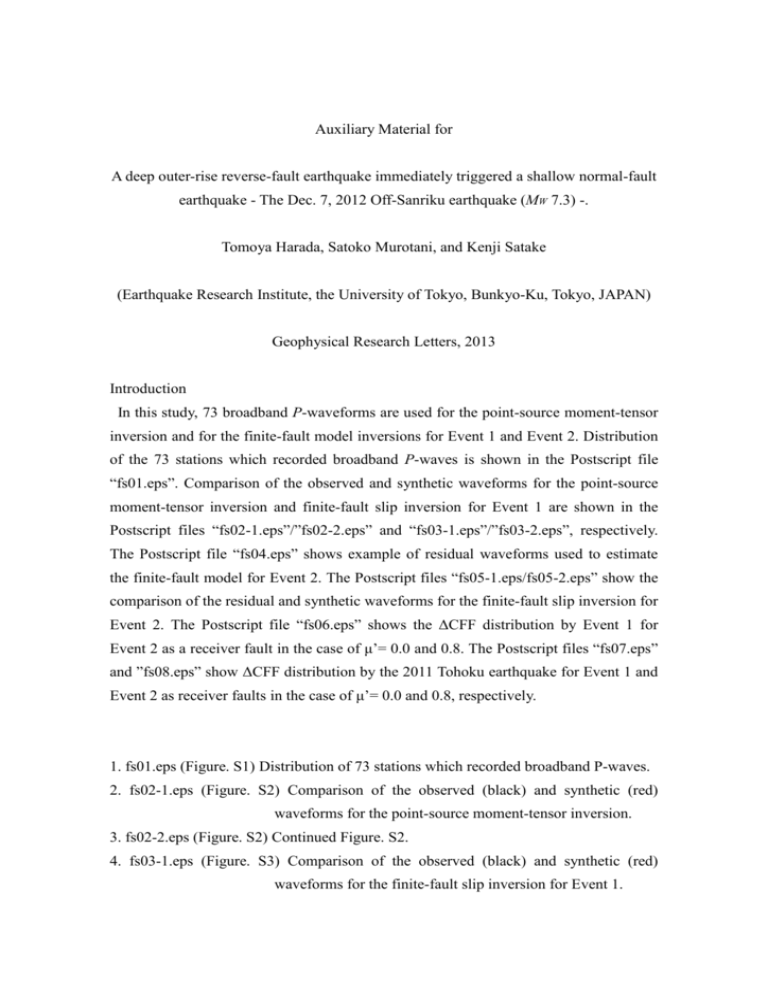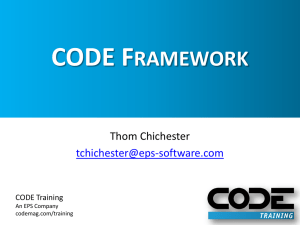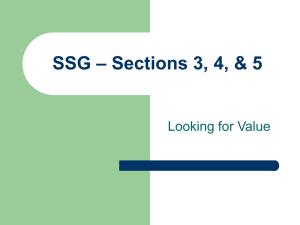Readme_Auxiliary Material_R2013GL057053
advertisement

Auxiliary Material for A deep outer-rise reverse-fault earthquake immediately triggered a shallow normal-fault earthquake - The Dec. 7, 2012 Off-Sanriku earthquake (MW 7.3) -. Tomoya Harada, Satoko Murotani, and Kenji Satake (Earthquake Research Institute, the University of Tokyo, Bunkyo-Ku, Tokyo, JAPAN) Geophysical Research Letters, 2013 Introduction In this study, 73 broadband P-waveforms are used for the point-source moment-tensor inversion and for the finite-fault model inversions for Event 1 and Event 2. Distribution of the 73 stations which recorded broadband P-waves is shown in the Postscript file “fs01.eps”. Comparison of the observed and synthetic waveforms for the point-source moment-tensor inversion and finite-fault slip inversion for Event 1 are shown in the Postscript files “fs02-1.eps”/”fs02-2.eps” and “fs03-1.eps”/”fs03-2.eps”, respectively. The Postscript file “fs04.eps” shows example of residual waveforms used to estimate the finite-fault model for Event 2. The Postscript files “fs05-1.eps/fs05-2.eps” show the comparison of the residual and synthetic waveforms for the finite-fault slip inversion for Event 2. The Postscript file “fs06.eps” shows the ΔCFF distribution by Event 1 for Event 2 as a receiver fault in the case of μ’= 0.0 and 0.8. The Postscript files “fs07.eps” and ”fs08.eps” show ΔCFF distribution by the 2011 Tohoku earthquake for Event 1 and Event 2 as receiver faults in the case of μ’= 0.0 and 0.8, respectively. 1. fs01.eps (Figure. S1) Distribution of 73 stations which recorded broadband P-waves. 2. fs02-1.eps (Figure. S2) Comparison of the observed (black) and synthetic (red) waveforms for the point-source moment-tensor inversion. 3. fs02-2.eps (Figure. S2) Continued Figure. S2. 4. fs03-1.eps (Figure. S3) Comparison of the observed (black) and synthetic (red) waveforms for the finite-fault slip inversion for Event 1. 5. fs03-2.eps (Figure. S3) Continued Figure. S5. 6. fs04.eps (Figure. S4) Example of residual waveforms. Black and red waveforms show the observed waveforms and the synthetic waveforms from Event 1, respectively. Blue waveforms show the residual waveforms (Solid part: used in the inversion, dashed part: not used in the inversion). 7. fs05-1.eps (Figure. S5) Comparison of the residual and synthetic waveforms for the finite-fault slip inversion for Event 2. Gray wiggles show residual waveforms which were not used in the inversion. 8. fs05-2.eps (Figure. S5) Continued Figure. S5. 9. fs06.eps (Figure. S6) ΔCFF distribution by Event 1 for Event 2 as a receiver fault in the case of μ’= 0.0 and 0.8. 10. fs07.eps (Figure. S7) ΔCFF (μ’= 0.0) distribution by the 2011 Tohoku for Event 1 and Event 2 as receiver faults. 11. fs08.eps (Figure. S8) ΔCFF (μ’= 0.8) distribution by the 2011 Tohoku for Event 1 and Event 2 as receiver faults.





